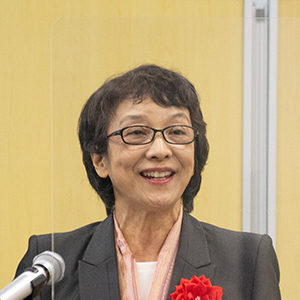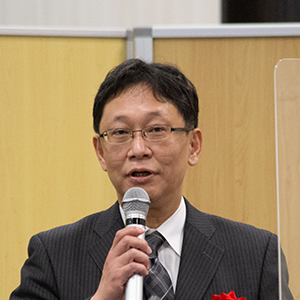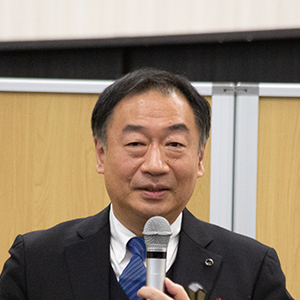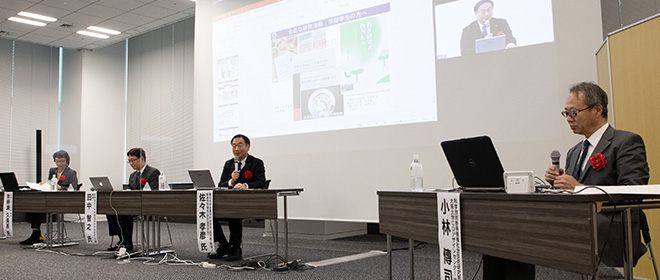Event Reports
Research Integrity Symposium "Considering Issues of Research Integrity from Each Research Field" (26 Nov '21)
Practices for research ethics may vary depending on the field of research. To promote effective research integrity at each university and institution, it is necessary that activities also take into account the characteristics of each research field.
At the Research Integrity Symposium "Considering Issues Research Integrity from Each Research Field" hosted by the Japan Science and Technology Agency (JST) on 26 November 2021, researchers from three research fields listed efforts for research integrity that are characteristic of their fields. In the panel discussion, several notable topics were discussed based on the contents of the lectures.
Lecture
Lecture 1: Humanities and Social Sciences

First, Professor Kumie Inose (Professor, Faculty of Letters, Konan University) gave a lecture on the characteristics of research misconduct in the humanities and social sciences and the challenges in research integrity efforts.
"A characteristic of research misconduct in the humanities and social sciences is the particularly high rate of plagiarism. There are many cases of plagiarism that are not malicious due to ignorance, ignorance, and unconsciousness, but there are serious cases that are not only citation errors. In addition to misconduct such as fabrication, falsification, and plagiarism (FFP), there are questionable research practices (QRP) such as duplicate submission, self-plagiarism, impropriate authorship, dishonest research management, and conflicts of interest. Even in the humanities and social sciences, the reality and perception of research misconduct are diversifying." At the beginning of the lecture, Professor Inose mentioned the differences in awareness of research ethics, and then explained the causes of unconscious plagiarism.
"In many fields in the humanities and social sciences, multiple publications that are researched and written by individuals get evaluated all together, instead of a single publication at a time. In that case, there are very few opportunities to receive comments from collaborators and reviewers. It is difficult to have an opportunity to notice research misconduct, and may come up only after receiving an accusation with publication. In recent years, "self-plagiarism" has been frequently pointed out in the humanities and social sciences, and this is thought to be due to the positioning of "bulletin papers" in the humanities and social sciences. Bulletin papers in the humanities and social sciences are also a place of difficulty in compiling them into a single book at a later date. However, currently the digitization of bulletin papers has progressed, and there are increasing cases where misconduct is discovered in publication, and increasingly problematic cases of self-plagiarism of bulletin papers being published in academic journals with a wider audience. "
In recent years, various research institutes have been introducing check tools as a countermeasure against plagiarism. Professor Inose's explanation is as follows.
"In recent years, many universities have used plagiarism checking tools to prevent plagiarism. However, proper citations are also detected, so the instructor must check them in the end with his own eyes. In addition, there is something called "back translation" which is used to bypass plagiarism checking tools by exploiting translation functions.* Plagiarism checking tools are useful, but they are not a foolproof solution to the problem. It is necessary to raise awareness of research integrity through education."
*A method of automatically translating another person's English paper into another language and then translating it back into English
"Research skills trading" refers to paid and anonymous services for various parts of the paper preparation process, such as data and research guidance. Regardless of the field, it is becoming a social problem because it may lead to research misconduct related to aspects such as data, traceability, and authorship."
In addition, Professor Inose pointed out several "temperature differences" as issues to be considered now, and touched on the following issues based on the results of last year's survey commissioned by the Ministry of Education, Culture, Sports, Science and Technology.
- There are various temperature differences and perceptions regarding research misconduct and research ethics such as differences in fields, like humanities and sciences, in the size of research institutions, between those supervising and being supervised, and between self-evaluation and peer evaluation.
- Most researchers consulted on research misconduct, are around the same age or are higher level researchers, and they are also not using the mandatory "consultation desk" at research institutes as much as one would expect.
- In the humanities and social sciences, education on "conflicts of interest" and "collaborative research" is insufficient compared to other fields.
Professor Inose concluded the report by suggesting that in the future it will be necessary for research institutes to evaluate individual efforts for research integrity, and for further cooperation among research institutes.
Lecture 2: Life Sciences

Professor Tomoyuki Tanaka (Professor, Department of Pharmacology, Department of Pathophysiology, Kyoto Pharmaceutical University) began by explaining characteristic issues of research integrity in the field of life science, and peer review after publication as a mechanism for discovering research misconduct. After that, he referred to the actual number of cases of research misconduct, and gave a lecture on the following contents.
"Based on the results of several overseas surveys, the number of accounts of life science research misconduct may actually be significantly higher than the actual number reported. * I think that the source of research misconduct may be related to the fact that the research environment is overly competitive."
*Bik, E., Casadevall, A., Fang, F. C. mBio, 2016, / Brainard, J. & You, J. Science, 2018 / de Vrieze, J. Science, 2021, Reference
"Research evaluation is closely related to the issue of the research environment. Originally, research evaluation is carried out by carefully examining the uniqueness, reproducibility, and human resource development of the research. However, in recent years, the amount of competitive funds accounting for research funding overall has increased rapidly, and the number of reviews has also increased. In order to evaluate and review in this situation, numerical indicators such as IF values and the number of articles have come to be used more prominently. With the increasing reliance on metrics in evaluation, researchers subsequently feel that they need to raise metrics as well as improve the content of their research in order to obtain research funding. In such a situation, FFP or QRP will cause a high number as a result. In addition, recent hot topics such as predatory publishing and paper mills also have an increasing demand for higher metrics."
Professor Tanaka cited low reproducibility as a problem in life science research.
"There are certain experiments that are difficult to reproduce, such as animal experiments, but there are also errors in statistical methods, inadequate records of experimental methods, and so on. The non-disclosure of raw data and poor research guidance have reduced reproducibility."
Professor Tanaka cites the decline effect as an example of a reproducibility issue.*
"There were cases where a paper showing a strong correlation between a gene and a disease was published in a journal with a high IF, but in subsequent follow-up tests, it was found that there was no such correlation or that it was extremely weak.
** Since the impactful results were published in high-IF journals without sufficient verification, many researchers lost time on less important research. This is not research misconduct, but it is a problem that occurs when reproducibility is neglected."
Professor Tanaka also pointed out that some of the problems unique to the life sciences field are that research activities are often conducted in the Faculty of Medicine by a concurrent doctor, that there are few opportunities for research training in the undergraduate curriculum, and that there is a relatively strong authoritarian culture.
Lastly, Professor Tanaka said, "Honesty is of the utmost importance in maintaining research integrity," and "it is necessary to create a mechanism for reminding researchers of their principles in regards to intellectual curiosity and when investigating things such as cures for diseases."
Lecture 3: Science and Engineering

The third lecture on the approach to fair research activities in the field of science and engineering was given by Takahiko Sasaki, Professor and Deputy Director of the Institute for Materials Research at Tohoku University, and special assistant to the President for Research Ethics.
"As a characteristic of science and engineering, the number of cases of research misconduct is smaller than other fields such as life sciences, and it can be difficult to identify content affected by research misconduct. In science, the purpose is the pursuit of truth, and even if things are inefficient, what matters the most is that it is achieved in the end. There is a culture where discussions are held regardless of format or authority, and there is a tendency to dislike standardization. On the other hand, in engineering the goal is the happiness and welfare of mankind. Things should be achieved efficiently, and there is an awareness of those who educate and those who learn, and those who make rules and those who preserve them. There is also a tendency to seek standardization. Due to these differences in research awareness between science and engineering, it is necessary to conduct research ethics education that is tailored to each."
Professor Sasaki described the approach to research misconduct prevention (including non-science and engineering) by classifying research misconduct into three categories: top-down, bottom-up, and unconscious.
"The top-down category is one in which the principal investigator (PI) seeks fame and reputation and tries to produce results that are in line with their own beliefs. As an approach to preventing research misconduct, principal investigators must understand, comply with, and uphold their responsibilities and roles. In bottom-up, young researchers are compelled to engage in research misconduct, such as being unable to get a position if they do not achieve desired results. An effective approach to research ethics education is to emphasize integrity, honesty, and what it means to be a researcher. In addition, there is unconscious research misconduct by even excellent young researchers, and I think it is difficult to provide effective research ethics education because individuals are not aware of the research misconduct in these instances."
However, the professor also feels that it is often difficult to educate senior principal investigators on compliance.
"In science, interest in research ethics education is low, perhaps because research misconduct is less likely to occur. Therefore, although it may seem naive, it is effective to always appeal to principles and truth. For this purpose, it is important that people who understand scientific research speak and share the reality of research ethics with researchers. On the other hand, engineering has a culture of conducting and receiving research ethics education, and it can be said that there is high susceptibility to research misconduct, including conflicts of interest. Therefore, I think it is effective to approach the institutional framework of research ethics education by a person who understands the characteristics of the field of engineering and the career stage."
In addition, Professor Sasaki introduced examples of Tohoku University's efforts.
"At Tohoku University, the headquarters and departments (faculties) work together to organize research ethics education programs tailored to each respective field, so I would like to introduce them as examples. Research ethics education is divided into six stages, from new students to professors. For example, in addition to holding workshops for faculty members at the "Research Integrity Advisor" stage, we also hold classes on the topic of research ethics and integrity for doctoral students. This can be seen on the website of the Office of Research Compliance, Division of Research Promotion, Tohoku University.*
Lastly, Professor Sasaki introduced the opinion from a survey of graduate students in his doctoral program that can "look back and say with 100% certainty that they have not committed research misconduct," that creating opportunities to reflect on oneself can help with career development and lead to the fostering of better awareness of research ethics. It was concluded that it is important to ensure the effectiveness of research ethics education by those responsible for the promotion of fair research activities and whether they understand their responsibilities.
Panel discussion
Following the lecture, a panel discussion was held with three speakers as panelists, moderated by Tadashi Kobayashi, Director of the Research and Development Center for Social Technology at the Japan Science and Technology Agency (JST) and specially appointed professor at the CENTER FOR THE STUDY OF CO* DESIGN at Osaka University.

Characteristic examples of each research field: Double posting
In the panel discussion, the characteristics of research misconduct in each research field were reviewed, and differences in each field were discussed. For example, it was confirmed that the term "double posting" differs depending on the research field.
- In the humanities and social sciences, the environment is not as competitive as other fields, and self-plagiarism becomes more an of issue due to improper references and citations to past works, rather than the problem of submitting research to multiple journals at the same time.
- In the field of life science, cases of publishing the contents of Japanese journals that are the exact same as papers originally in English journals has also been pointed out as a problem.
- In the case of science and engineering, the author does not carefully check the submission regulations and an submission in engineering is made in Japanese with the same contents as an original journal in English, which may result in a double post.
Recent trends in research misconduct affected by technological innovation
The moderator, Professor Kobayashi, talked to the panelists about the back translation that Professor Inose mentioned in his lecture, and asked them about the technological innovations in each field.
Professor Tanaka reported that in the life science field, tampering has occurred due to the improvements in the capability of image editing software in recent years. Professor Sasaki introduced that Tohoku University held an effective seminar on "image processing to avoid fraudulent image accusations" with software developers and others as lecturers.
Issues other than specified research misconduct: Research skills trading
The participants asked questions about research skills trading, and the lecturers pointed out the following points.
- The underlying circumstances of the situation is that some upcoming researchers are unable to obtain the necessary education and support from their superiors, and their education and training is also not highly evaluated.
- In the past, individual research was the norm, but many current research projects are much done on a larger scale with diversified work, and require a large number of research assistants. Therefore, researchers who do not have the sufficient resources have to rely on outsourcing.
- Even those who provide their skills may not be able to demonstrate them in the place where they were due to a lack of career in research and funding.
- The scope and methods of skill delivery need to be further discussed in the future.
Common topics in research fields: Research evaluation and research environment
Professor Kobayashi reiterated the influence of the competitive research environment and the bias of numerical indicators as one of the factors causing research misconduct, which Professor Tanaka also pointed out in his lecture. "In recent years, the surging bias of numerical indicators has become a problem in the world, and reflective discussions and declarations have been issued. In Japan, the Science Council of Japan (SCJ) translated these declarations into Japanese and the results of discussions on the best way to evaluate them were published the day before the Symposium.* I hope that these recommendations will also be used as materials to prevent research misconduct by conducting appropriate research evaluations." He then introduced the recommendations.
Consultation desk personnel
In his lecture, Professor Inose reported on the results of the survey that the "consultation desks" established at each university and institution for research misconduct were not always being used as the primary place of consultation. When Mr. Kobayashi asked why, Professor Inose answered with "The consultant may think that the representative at the consultation desk will not understand the contents of their consultation even if they explain it to them. Shouldn't we have consultation desk personnel with their own area of specialization, who can sufficiently understand the contents for consultations and connect it to the relevant departments?"
Professor Sasaki said, "At Tohoku University, the consultation desks of each department are used more often than the one that represent the entire university. I think it would be a good idea to have someone take charge of a one-stop consultation service that includes not only research misconduct, but also life situations and harassment, and can then direct cases to the necessary departments."
Professor Inose explained that in contrast to the fact that experts in research integrity have already been assigned from various positions and authorities overseas, Japan is studying to ensure the quality of research integrity by establishing certain qualifications for those in charge of research ethics consultation.
Senior issues and personnel development
Professor Kobayashi asked Professor Sasaki to reiterate about the approaches to research ethics education for top-down research misconduct by senior researchers or principal investigators and bottom-up research misconduct by young researchers that were mentioned in his lecture.
Workshops for advisors
Professor Sasaki answered with the following.
"Senior personnel tend to find it difficult to change the mindset they have developed, but familiarity and understanding with compliance acts as a deterrent. On the other hand, students and young researchers are motivated to reflect on themselves when receiving research ethics education, and the effects of education are expected to be very high, so I think we can have high expectations in the future. Tohoku University also organizes workshops in each department for senior faculty members who serve as research integrity advisors. There are times when ideas conflict due to differences in fields, but there are lively discussions among senior faculty members based on honest opinions."
Professor Kobayashi praised Tohoku University's efforts as opportunities for invaluable experiences for senior personnel.
In addition, Professor Inose made the following remarks about research ethics education for senior faculty members.
"The problem with senior faculty members who lack awareness of research ethics is that they are both researchers and educators, so they can reproduce misunderstandings to the next generation through teaching students. By taking advantage of this, it's essential to emphasize the importance of educating senior faculty members and encourage them to develop students with world-class research ethics, which will in turn create a passion for research ethics in those seniors."
At the end of the Symposium, Professor Kobayashi concluded the roughly 600 person event by quoting the words of the graduate students mentioned in the lecture and expressed his expectation for constant thinking and discussion rather than haste for conclusions.*
*"It doesn't matter if a conclusion wasn't found, as long as you value the fact that is a discussion worth having."

